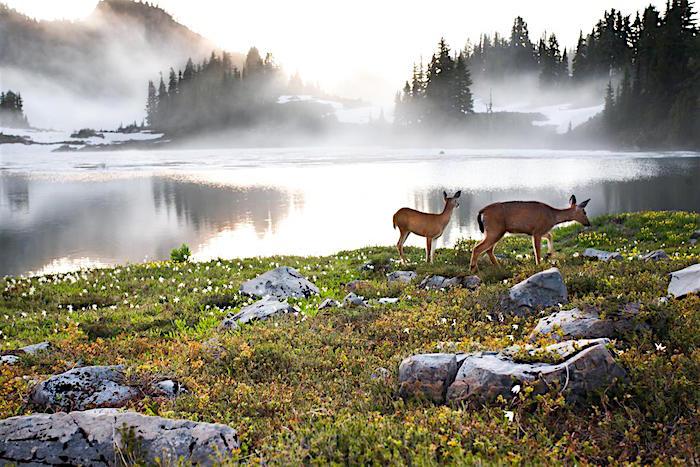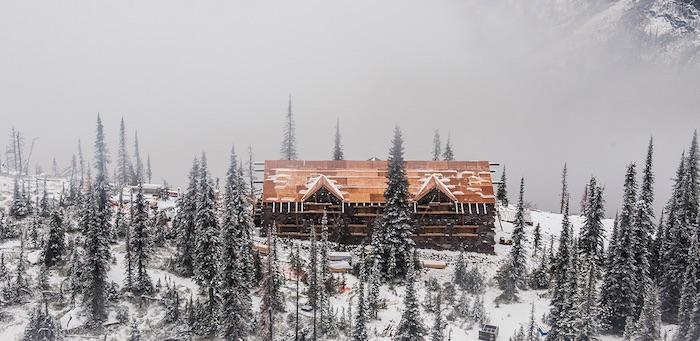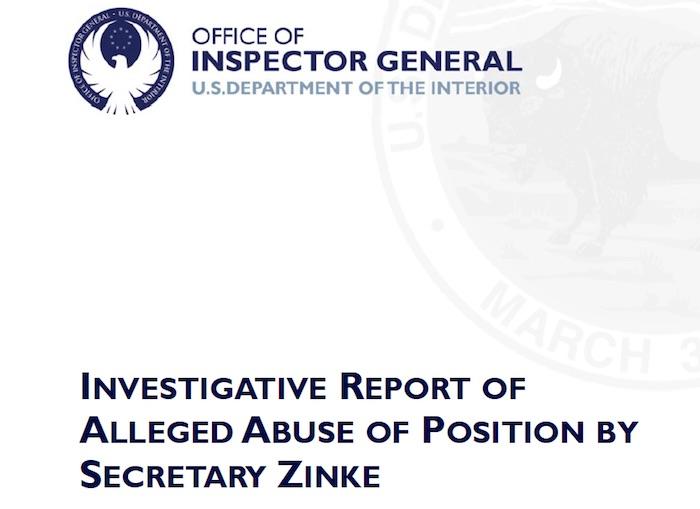
An aspiring congressman thinks Olympic National Park should be given to the state of Washington/USGS, Robin Munshaw, Simon Fraser University
There really never is a dull moment when it comes to national parks. Not when there's a candidate for Congress saying Olympic National Park should be turned over to the state of Washington, when Interior Secretary Ryan Zinke praises the stabilization of a small backcountry lodge in Glacier National Park but is mum on Grand Canyon National Park's leaky water system, and when the National Park Service looks the other way regarding its role not to interfere with natural processes.
Relinquish Olympic National Park!
Douglas Dightman is a Republican running for Congress in Washington state. A medical doctor hoping to unseat U.S. Rep. Derek Kilmer, Dightman figures that since Olympic is located entirely in Washington, it should be owned and run by the state.
“I’m not sure why we can’t just give the park to the state of Washington and let them manage it, let the people who live around it have more control with what goes on in the park … and have more control at the local level," Dightman said the other day at a League of Women Voters forum that was covered by the Peninsula Daily News.
Kilmer pointed out, though, that it's nice that the entire nation, through the federal budget, pays for the park's upkeep. And with a $120 million maintenance backlog and $12 million annual budget, Olympic can be expensive to operate. With Washington's state and local budget deficit running about $96.3 billion, how likely is it that the state's voters would agree with Dightman?
“It is a good thing that as a nation we collectively say these are public assets that we want to maintain and that that cost is not entirely borne by the residents of the Olympic Peninsula," Kilmer pointed out.
If there ever does come a serious consideration to transfer Olympic to the state, let's hope there's a good appraisal on just what the state should pay for it.

Winter stabilization of Sperry Chalet in Glacier National Park has been completed/Glacier Conservancy
Stablizing Sperry Chalet
3,000 vs. 6 million
Those numbers represent, roughly, the number of visitors who in the past have visited the Sperry Chalet in Glacier National Park during its two-month summer season, and the number of visitors who crowd the South Rim of Grand Canyon National Park each year.
Sperry, of course, burned down in September 2017 as part of the collateral damage caused by the Sprague wildfire. Secretary Zinke, a Montanan, quickly came to the rescue, with $12 million from a pot of $138 million Congress gave him to "address only longstanding deferred maintenance and major construction related requirements of the Service.”
The other week, Glacier officials announced that the first phase of rebuilding Sperry -- stabilizing the backcountry lodge for the winter -- had been completed, and the Interior secretary was quick to applaud.
"I cannot say enough good things about the great team rebuilding Sperry Chalet. I've seen the photos and the progress the construction crew has made is incredible," said Zinke. "After last year's devastating fire, I made rebuilding Sperry Chalet a top priority. It wouldn't have been possible without our private partners, community members, and entire Glacier National Park team. I look forward to visiting Sperry again soon."
Meanwhile, some 1,140 miles to the south, the antiquated, decrepit, and leak-prone Transcanyon Waterline that funnels water from the North Rim of Grand Canyon to the South Rim has been springing leaks recently and forcing water conservation measures on South Rim visitors and guests.
The Interior secretary visited Grand Canyon in September to rally support for legislation in Congress that would begin to pay down the National Park Service's roughly $12 billion maintenance backlog. While Zinke helped slap paint on South Rim cabins that date to the 1930s, he didn't mention dipping into that $138 $126 million to help address the leaking pipeline, which most assuredly qualifies as part of the maintenance backlog as well as "major construction."
Park officials have a plan for addressing the matter, but until it is formally approved by the Park Service and bids sought, the repair/replacement cost won't be fully known. But it has been ballparked between $100 million and $150 million. Fortunately, the park does have the funding to continue searching near Phantom Ranch for a new water source for the pipeline.

A wolf recovery program this fall brought four wolves to Isle Royale National Park, where just these two had been remaining/Michigan Tech
Not All Natural Processes Are Equal
Chapter 4 of the National Park Service's Management Policies addresses how superintendents should manage natural resources in their parks. It clearly states that natural processes should typically be allowed to play out, unimpeded.
Natural resources will be managed to preserve fundamental physical and biological processes, as well as individual species, features, and plant and animal communities. The Service will not attempt to solely preserve individual species (except threatened or endangered species) or individual natural processes; rather, it will try to maintain all the components and processes of naturally evolving park ecosystems, including the natural abundance, diversity, and genetic and ecological integrity of the plant and animal species native to those ecosystems. Just as all components of a natural system will be recognized as important, natural change will also be recognized as an integral part of the functioning of natural systems. (Emphasis added)
At Isle Royale National Park, the Park Service skirted that guidance when it committed nearly $700,000 for a three-year wolf recovery program -- crating up wolves from other areas of Michigan and Minnesota, and maybe Canada, and shipping them to the park -- to rebuild the predator's population so it might tamp down the burgeoning moose population that is eating up the island's vegetation.
It wasn't a quick, and certainly not an easy, decision. But it now raises questions of how active managers elsewhere in the park system should be in controlling the dynamics of their natural resources, whether the Park Service decision was weighted to support the long-term prey-predator research done by Michigan Tech in Houghton, Mich., and whether the current recovery program will forever forward require Isle Royale managers to manipulate natural processes to achieve a desired result. Some have even suggested that the Park Service should bring lynx and caribou, which were native to the island, back there.

Those IG Reports
The other day, the Interior Department's Inspector General completed yet another report on an investigation into Secretary Zinke's ethical behavior (attached below and to be formally released this week). It focused on his practice of having his wife, who is not a federal employee, travel with him (Secretary Zinke said he reimbursed the government for her travel costs. While Interior policy had prohibited family members from traveling in government vehicles, it changed that policy on July 27, 2018, after it became aware of the IG investigation into Lolita Zinke's travels with her husband); on the $25,000 cost of having a U.S. Park Police security detail accompany him and his wife on a vacation to Turkey (the secretary said the Park Police recommended the detail, he didn't ask for it); on other travel costs and whether they were appropriate, and; whether Zinke ordered a former employee to walk his dog (no he did not, according to the IG).
Whether this behavior by the secretary is greatly contrary to that expected from a public servant no doubt is colored by one's political persuasion. But one glaring aspect that stands out, and which everyone should be concerned about, is the final sentence of the report, concerning the disposition of the findings:
We provided this report to the Deputy Secretary of the Interior for any action deemed appropriate.
Just what are the odds that David Bernhardt will send his boss to the woodshed?



Comments
Excellent article, Kurt. Thank you.
But I doubt if anyone in Washington right now will pay any attention.
Ditto, Lee above.
It has become the era of obvious sins becoming the standard, and the rules changing on what is a sin.
WHAT A LOAD OF GARBAGE!!!! AND THIS REPORT IS HANDED TO THE SECRETARY'S SUBORDINATE FOR ACTION..GIVE ME A BREAK
Deputy Solicitor Edward Keable, General Law, acknowledged that allowing Lolita Zinke in Government vehicles was "not in conformance with the language" of the policy but added that in his opinion, Secretary Zinke was not beholden to DOI policy as long as this latitude did not violate statutory or regulatory provisions. This was also the opinion of Deputy Interior Secretary David Bernhardt, who said the policy applied to DOI employees but not necessarily to a Secretary. He also said this was a policy a Secretary could change "with the stroke of a pen." Principal Deputy Solicitor Daniel Jorjani said he was unsure whether a DOI Secretary could violate DOI policy, but he said he did not consider a Secretary's spouse riding in Government vehicles to be in violation of or opposition to the DOI's motor vehicle policy because Secretary Zinke was required to use Government-owned security vehicles and did not have the option of using his private vehicle if he wanted to take his wife on a trip with him.
I guess the message below (excerpts provided here) to the troops on October 10th from Dep Sec rings a bit more hollow right now...
Interior Team,
A little over a year ago, I circulated a message explaining that we were going to be striving for greater accountability within the Department of the Interior. From day one, Secretary Zinke and I have been committed to leaving the Department in better shape than we found it; this includes addressing employee misconduct and harassment and improving our ethics program....... In my first message to you, I included the 14 principles from the Standards of Ethical Conduct for Employees of the Executive Branch. Consistent with the emphasis on establishing a more ethical workplace culture, we directed Scott A. de la Vega, the Designated Agency Ethics Official, to identify how to strengthen the Department's ethics programs, both at the Departmental Ethics Office (DEO) level and at the Bureau and Office level. Over the past several months, we have worked diligently with the DEO and ethics officials throughout the various Bureaus and Offices to design and begin implementing robust and revised ethics programs. One essential element of these efforts involves an unprecedented increase in the number of professional ethics officials throughout the Department. This expansion of the Department's ethics programs will enable these officials to directly assist, educate, and provide employees with the tools needed to support ethical decision making throughout the Department. I believe this effort will be a lasting change that fundamentally institutionalizes an ethical culture. I also believe it is unparalleled in its scope......
Despite these efforts, we can only take action when we are aware of misconduct or unethical behavior. For this to happen, employees have to be willing to come forward. I want you to know that your leadership is listening, and we are committed to holding individuals accountable when they have failed in their duties and obligations
"...rings a bit more hollow..." is now a contender for 'understatement of the year'.